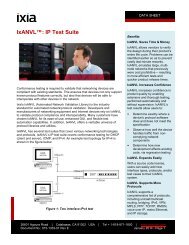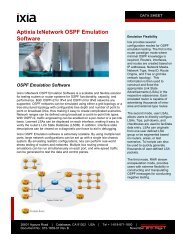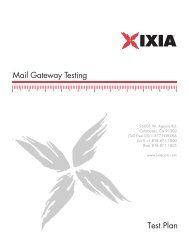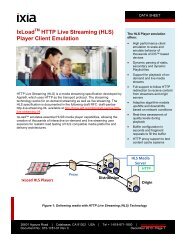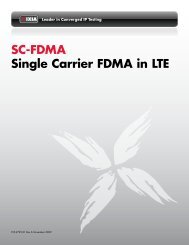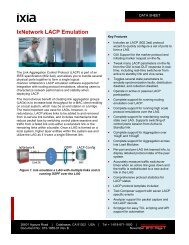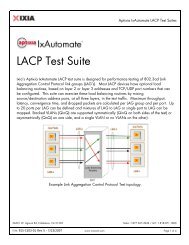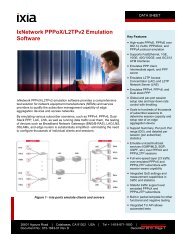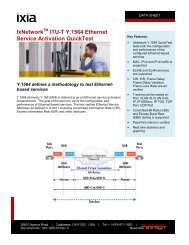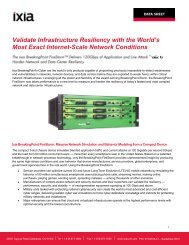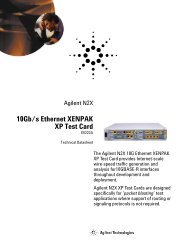Testing PPPoX and L2TP Broadband Access Devices - Ixia
Testing PPPoX and L2TP Broadband Access Devices - Ixia
Testing PPPoX and L2TP Broadband Access Devices - Ixia
Create successful ePaper yourself
Turn your PDF publications into a flip-book with our unique Google optimized e-Paper software.
<strong>Testing</strong> <strong>PPPoX</strong> <strong>and</strong> <strong>L2TP</strong><br />
Broadb<strong>and</strong> <strong>Access</strong> <strong>Devices</strong>
Contents<br />
1. <strong>PPPoX</strong> Client Performance <strong>and</strong> Scalability Test·········································································· 1<br />
1.1 Objective ······················································································································ 1<br />
1.2 Setup··························································································································· 1<br />
1.3 Input Parameters············································································································ 2<br />
1.4 Test Methodology <strong>and</strong> Result Generation ············································································ 2<br />
2.. <strong>PPPoX</strong> Client <strong>and</strong> Server Performance <strong>and</strong> Scalability Test·························································· 7<br />
2.1 Objective ······················································································································ 7<br />
2.2 Setup··························································································································· 7<br />
2.3 Input Parameters············································································································ 7<br />
2.4 Test Methodology <strong>and</strong> Result Generation ············································································ 7<br />
3. LNS Performance <strong>and</strong> Scalability Test······················································································· 8<br />
3.1 Test Objective ··············································································································· 8<br />
3.2 Setup··························································································································· 8<br />
3.3 Input Parameters············································································································ 8<br />
3.4 Test Methodology <strong>and</strong> Result Generation ············································································ 9<br />
4. LAC Performance <strong>and</strong> Scalability Test····················································································· 12<br />
4.1 Test Objective ············································································································· 12<br />
4.2 Setup························································································································· 12<br />
4.3 Input Parameters·········································································································· 12<br />
3.4 Test Methodology <strong>and</strong> Result Generation ·········································································· 13<br />
Copyright © 2004 by <strong>Ixia</strong><br />
All rights reserved<br />
IXIA<br />
26601 West Agoura Road, Calabasas, CA 91302<br />
(877) FOR-IXIA<br />
This Test Plan Primer contains a general outline for testing a particular technology. Not all the capabilities of <strong>Ixia</strong><br />
technology have been exposed in this document. Please feel free to contact us if additional capabilities are required.
Overview<br />
Modern broadb<strong>and</strong> networks deployed to provision xDSL<br />
or cable-based high-speed Internet access services to<br />
residential <strong>and</strong> commercial users rely on a number of<br />
complex devices to offer a high quality experience to the<br />
user. Prior to network deployment, these devices are<br />
commonly tested for:<br />
• Performance, e.g. can the device h<strong>and</strong>le a specified<br />
number of session setup requests per second<br />
• Scalability, e.g. does the device meet its maximum<br />
session specifications<br />
• Functionality, e.g. do the advanced firmware features in<br />
the device interoperate with other parts of the network<br />
while maintaining scalability<br />
This document provides test case examples covering these<br />
requirements for three main device classes, namely:<br />
• Broadb<strong>and</strong> Remote <strong>Access</strong> Servers (BRAS)<br />
• Layer 2 <strong>Access</strong> Servers<br />
• Layer 2 Network Servers<br />
Four iterative test case examples are being presented.<br />
• <strong>PPPoX</strong> client performance <strong>and</strong> scalability test<br />
• <strong>PPPoX</strong> client <strong>and</strong> server performance <strong>and</strong> scalability test<br />
• <strong>L2TP</strong> LAC performance <strong>and</strong> scalability tests with<br />
<strong>PPPoX</strong> traffic<br />
• <strong>L2TP</strong> LNS performance <strong>and</strong><br />
scalability tests<br />
<strong>PPPoX</strong> includes a number of<br />
technologies such as PPPoE,<br />
PPPoA, PPPoEoA, PPPoEoVLAN.<br />
The <strong>PPPoX</strong> version tested depends<br />
on the interface options available in<br />
the Device under Test (DUT)/<br />
System under Test (SUT) <strong>and</strong> the<br />
corresponding <strong>Ixia</strong> Load Module.<br />
While the total number of <strong>PPPoX</strong><br />
sessions needed to perform stress<br />
tests depends on capabilities of the<br />
DUT, this document assumes that<br />
the test tool is capable of generating<br />
32,000 sessions per test.<br />
1. <strong>PPPoX</strong> Client Performance<br />
<strong>and</strong> Scalability Test<br />
1.1 Objective<br />
The objective of this test is to characterize the performance<br />
of both LAC <strong>and</strong> LNS/B-RAS devices while simulating<br />
32,000 <strong>PPPoX</strong> sessions. The test is split into three phases,<br />
namely:<br />
• Baseline session setup <strong>and</strong> teardown tests.<br />
• Simulating access link failure test. This can be achieved<br />
by simply disconnecting <strong>and</strong> reconnecting the link<br />
from the test tool to the DUT to observer service<br />
recovery times.<br />
• Simulate DUT failure test. This can be achieved by<br />
re-booting the DUT.<br />
1.2 Setup<br />
The DUT may consist of single or multiple devices (i.e.<br />
<strong>Access</strong> concentrator/LAC <strong>and</strong> LNS or LNS or BRAS, etc.).<br />
As shown in Figure 1, an <strong>Ixia</strong> GigE Load Module port<br />
(copper or fiber) or ATM Load Module port (OC3 or<br />
OC12) may be used to generate the required number<br />
of subscribers (access users) for one or more <strong>PPPoX</strong><br />
sessions.<br />
Figure 1: <strong>PPPoX</strong> client emulation setup<br />
PoE Test Plan Copyright © <strong>Ixia</strong>, 2004 1
1.3 Input Parameters<br />
The primary input parameters for each phase include:<br />
• Session setup rate & latency – maximum, minimum <strong>and</strong><br />
average time <strong>and</strong> latency to establish all sessions with<br />
either no authentication, PAP or CHAP authentication for<br />
<strong>PPPoX</strong> clients (access side only).<br />
• Interfaces, VLANs <strong>and</strong> domain groups.<br />
• Traffic generation – upstream/downstream/bi-directional<br />
for stateless L3/L4 traffic (IMIX or fixed frame<br />
distributions).<br />
• Session teardown rate.<br />
1.4 Test Methodology <strong>and</strong> Result<br />
Generation<br />
• Session setup test:<br />
− Test tool to generate 32,000 <strong>PPPoX</strong> sessions.<br />
− Record setup rates <strong>and</strong> latency measurements.<br />
See Figures 2 <strong>and</strong> 3 below for details.<br />
Figure 2: Session setup results configuration<br />
The connection rate chart in the test tool displays the number <strong>and</strong><br />
rate of <strong>PPPoX</strong> connections, number of active sessions, <strong>and</strong> the<br />
number of sessions that are in the discovery or negotiation stage.<br />
2 Copyright © <strong>Ixia</strong>, 2004 PoE Test Plan
Figure 3: Latency results<br />
− Record the number of sessions in the DUT.<br />
PoE Test Plan Copyright © <strong>Ixia</strong>, 2004 3
• Traffic generation over <strong>PPPoX</strong> test:<br />
− Test tool to generate L2/3 stateless traffic. For<br />
example, 20% upstream <strong>and</strong> 80% downstream<br />
IMIX traffic (64, 128, 512, 1024 <strong>and</strong> 1518 byte<br />
frames over TCP). See Figure 4 for setup details.<br />
Figure 4: Stateless traffic generation options in Test tool<br />
4 Copyright © <strong>Ixia</strong>, 2004 PoE Test Plan
• Record throughput results. See Figure 5 for example of<br />
graphical representation of results.<br />
Figure 5: Test tool stateless traffic generation chart<br />
PoE Test Plan Copyright © <strong>Ixia</strong>, 2004 5
• Session tear down test:<br />
− Test tool to tear down sessions at a fixed rate (e.g.<br />
100 sessions per second). See Figure 6 for details.<br />
•<br />
Figure 6: PPP session tear down<br />
6 Copyright © <strong>Ixia</strong>, 2004 PoE Test Plan
• Simulate an access link failure for each of the above test<br />
cases. Note the number of session retries <strong>and</strong> session<br />
recovery times.<br />
• Simulate a system failure for each of the above test<br />
cases.<br />
Note the number of session retries <strong>and</strong> session recovery<br />
times.<br />
2. <strong>PPPoX</strong> Client <strong>and</strong> Server<br />
Performance <strong>and</strong> Scalability Test<br />
2.1 Objective<br />
The objective of this test is to characterize the performance<br />
of both LAC <strong>and</strong> LNS/B-RAS devices when forwarding<br />
32,000 <strong>PPPoX</strong> sessions including both control <strong>and</strong> data<br />
plane traffic. The test is split into two phases, namely:<br />
• Control plane traffic generation (PPPoE, PPPoA,<br />
PPPoEoA, PPPoEoVLAN).<br />
• Data plane traffic generation (IMIX <strong>and</strong> fixed frame sizes<br />
at 100% utilization).<br />
2.2 Setup<br />
When emulating both client <strong>and</strong> server, the test tool creates<br />
the requested number of subscribers (i.e. 32,000 in this<br />
case) as well as terminates the incoming PPP sessions,<br />
thus bracketing the DUT. The DUT may consist of single or<br />
multiple devices (e.g. DSLAM).<br />
As shown in Figure 7, an <strong>Ixia</strong> GigE Load Module port<br />
(copper or fiber) or ATM Load Module port (OC3 or OC12)<br />
may be used to generate the required number of PPP<br />
sessions. In addition, these ports generate the data plane<br />
IP traffic.<br />
2.3 Input Parameters<br />
The primary input parameters for each phase include:<br />
• Session setup rate & latency – maximum, minimum <strong>and</strong><br />
average time <strong>and</strong> latency to establish all sessions with<br />
either no authentication, PAP or CHAP authentication.<br />
• Interfaces, VLANs <strong>and</strong> domain groups for access <strong>and</strong><br />
network ports.<br />
• Traffic generation – upstream/downstream/bi-directional<br />
for stateless L3/L4 traffic (IMIX or fixed frame<br />
distributions).<br />
• Session teardown rate.<br />
2.4 Test Methodology <strong>and</strong><br />
Result Generation<br />
• Session setup test:<br />
− Test tool to generate 32,000 <strong>PPPoX</strong> sessions.<br />
− Record setup rates <strong>and</strong> latency measurements<br />
outlined in section 1.2.<br />
− Record the number of sessions in the DUT.<br />
• Traffic generation over <strong>PPPoX</strong> test:<br />
− Test tool to generate L2/3 stateless traffic. For<br />
example, 20% upstream <strong>and</strong> 80% downstream<br />
IMIX traffic (64, 128, 512, 1024 <strong>and</strong> 1518 byte<br />
frames over TCP). See Figure 3 in Section 1 for<br />
setup details.<br />
• Session tear down test:<br />
− Test tool to tear down sessions at a fixed rate<br />
(e.g. 100 sessions per second).<br />
<strong>Access</strong> Side<br />
- PPPoE, PPPoEo802.1q<br />
- PPPoEoA, PPPoA<br />
DUT<br />
<strong>Access</strong> Concentrator<br />
Network Side<br />
- PPPoE, PPPoEo802.1q<br />
- PPPoEoA, PPPoA<br />
10/100/1000 Ethernet<br />
Or OC3/OC12 ATM<br />
10/100/1000 Ethernet<br />
Or OC3/OC12 ATM<br />
Figure 7: <strong>PPPoX</strong> client <strong>and</strong> server emulation setup<br />
PoE Test Plan Copyright © <strong>Ixia</strong>, 2004 7
3. LNS Performance <strong>and</strong><br />
Scalability Test<br />
3.1 Test Objective<br />
The objective of this test is to emulate multiple LACs to<br />
characterize the performance of LNS devices when<br />
forwarding 32,000 <strong>PPPoX</strong> sessions including both control<br />
<strong>and</strong> data plane traffic. The test is split into four phases,<br />
namely:<br />
• <strong>L2TP</strong> Tunnel setup, i.e. the rate at which the LNS can<br />
terminate 32,000 tunnels.<br />
• Tunneled session setup phase, i.e. the rate at which the<br />
LACs can initiate 16k <strong>L2TP</strong> tunnels with or without<br />
PAP/Chap authentication.<br />
• <strong>PPPoX</strong> session establishment through <strong>L2TP</strong> tunnels.<br />
• Data plane <strong>and</strong> keep-alive traffic generation (IMIX <strong>and</strong><br />
fixed frame sizes at 100% utilization).<br />
3.3 Input Parameters<br />
The primary input parameters for each phase include:<br />
• <strong>PPPoX</strong>session setup rate & latency – maximum,<br />
minimum <strong>and</strong> average time <strong>and</strong> latency to establish all<br />
sessions with either no authentication, PAP or CHAP<br />
authentication.<br />
• <strong>PPPoX</strong> interfaces, VLANs <strong>and</strong> domain groups for access<br />
<strong>and</strong> network ports.<br />
• <strong>L2TP</strong> sessions per tunnel, Hello Request intervals <strong>and</strong><br />
<strong>L2TP</strong> data plane options (e.g. UDP source <strong>and</strong><br />
destination ports).<br />
• Traffic generation – upstream/downstream/bi-directional<br />
for stateless L3/L4 traffic (IMIX or fixed frame<br />
distributions).<br />
• Session teardown rate.<br />
3.2 Setup<br />
In this test, Test tool emulates multiple LACs creating up to<br />
32,000 <strong>L2TP</strong> tunnels <strong>and</strong> then running <strong>PPPoX</strong> session <strong>and</strong><br />
data traffic over those tunnels. As depicted in Figure 8,<br />
either <strong>Ixia</strong> Ethernet or ATM ports may be used to simulate<br />
the number of subscribers on the access side of the LNS.<br />
The network side of the LNS is also connected to either <strong>Ixia</strong><br />
ATM or Ethernet ports to receive or generate IP traffic.<br />
<strong>Access</strong> Side<br />
- PPPoEo<strong>L2TP</strong><br />
- PPPoEo802.1qo<strong>L2TP</strong><br />
- PPPoAo<strong>L2TP</strong><br />
- PPPoAo<strong>L2TP</strong>oA<br />
LNS<br />
Network Side<br />
- IP (Ethernet, VLAN or<br />
ATM RFC 1483)<br />
10/100/1000 Ethernet<br />
Or OC3/OC12 ATM<br />
10/100/1000 Ethernet<br />
Or OC3/OC12 ATM<br />
10/100/1000 Ethernet<br />
Or OC3/OC12 ATM<br />
Figure 8: <strong>PPPoX</strong> client emulation setup<br />
8 Copyright © <strong>Ixia</strong>, 2004 PoE Test Plan
3.4 Test Methodology <strong>and</strong><br />
Result Generation<br />
• Session setup test:<br />
− Test tool to emulate a specified number of LACs<br />
with the parameters outlined in Figure 9 below.<br />
− Test tool to generate 32,000 <strong>L2TP</strong> sessions. See<br />
Figure 10 for a graphical representation of 32,000<br />
active sessions spread over 24,000 <strong>L2TP</strong> tunnels.<br />
− Test tool to generate 32,000 <strong>PPPoX</strong> sessions.<br />
− Record setup rates <strong>and</strong> latency measurements<br />
outlined in section 1.2. See Figures 2 <strong>and</strong> 3<br />
for details.<br />
− Record the number of sessions in the DUT.<br />
Figure 9: LAC parameter definition<br />
PoE Test Plan Copyright © <strong>Ixia</strong>, 2004 9
Figure 10: 32,000 <strong>L2TP</strong> sessions over 24,000 tunnels<br />
10 Copyright © <strong>Ixia</strong>, 2004 PoE Test Plan
• Traffic generation over <strong>PPPoX</strong> test:<br />
− Test tool to generate L2/3 stateless traffic. For<br />
example, 20% upstream <strong>and</strong> 80% downstream<br />
IMIX traffic (64, 128, 512, 1024 <strong>and</strong> 1518 byte<br />
frames over TCP). See Figure 3 in Section 1 for<br />
setup details.<br />
• Session tear down test:<br />
− Test tool to tear down sessions at a fixed rate (e.g.<br />
100 sessions per second). See Figure 11 for details.<br />
Figure 11: <strong>L2TP</strong> session/tunnel teardown<br />
PoE Test Plan Copyright © <strong>Ixia</strong>, 2004 11
4. LAC Performance <strong>and</strong><br />
Scalability Test<br />
4.1 Objective<br />
The objective of this test is measure the performance of<br />
LAC devices when forwarding 32,000 <strong>PPPoX</strong> sessions<br />
including both control <strong>and</strong> data plane traffic (including keepalives)<br />
over 32,000 <strong>L2TP</strong> tunnels. The test tool in LNS<br />
emulation mode allows the user to terminate both LAC<br />
initiated tunnels <strong>and</strong> <strong>PPPoX</strong> sessions. The test is split into<br />
three steps, namely:<br />
• Tunneled session setup phase, i.e. the rate at which the<br />
LACs can initiate 16k <strong>L2TP</strong> tunnels with or without<br />
PAP/Chap authentication.<br />
• <strong>PPPoX</strong> session establishment through <strong>L2TP</strong> tunnels.<br />
• Data plane <strong>and</strong> keep-alive traffic generation (IMIX <strong>and</strong><br />
fixed frame sizes at 100% utilization).<br />
4.2 Setup<br />
In this test, Test tool emulates multiple <strong>PPPoX</strong> clients<br />
creating up to 32,000 PPP sessions on the access side<br />
<strong>and</strong> terminate 32,000 <strong>L2TP</strong> <strong>and</strong> <strong>PPPoX</strong> sessions coming in<br />
from the DUT (LAC). The network side of the LNS is also<br />
connected to either <strong>Ixia</strong> ATM or Ethernet ports to receive<br />
or generate IP traffic.<br />
4.3 Input Parameters<br />
The primary input parameters for each phase include:<br />
• <strong>PPPoX</strong>session setup rate & latency – maximum,<br />
minimum <strong>and</strong> average time <strong>and</strong> latency to establish all<br />
sessions with either no authentication, PAP or CHAP<br />
authentication.<br />
• <strong>PPPoX</strong> interfaces, VLANs <strong>and</strong> domain groups for access<br />
<strong>and</strong> network ports.<br />
• <strong>L2TP</strong> sessions per tunnel, Hello Request intervals <strong>and</strong><br />
<strong>L2TP</strong> data plane options (e.g. UDP source <strong>and</strong><br />
destination ports).<br />
• Traffic generation – upstream/downstream/bi-directional<br />
for stateless L3/L4 traffic (IMIX or fixed frame<br />
distributions).<br />
• Session teardown rate.<br />
<strong>Access</strong> Side<br />
- PPPoE<br />
- PPPoEo802.1q<br />
- PPPoA<br />
BRAS<br />
Network Side<br />
- IP (Ethernet, VLAN or<br />
ATM RFC 1483)<br />
10/100/1000 Ethernet<br />
Or OC3/OC12 ATM<br />
10/100/1000 Ethernet<br />
Or OC3/OC12 ATM<br />
10/100/1000 Ethernet<br />
Or OC3/OC12 ATM<br />
12 Copyright © <strong>Ixia</strong>, 2004 PoE Test Plan
4.4 Test Methodology <strong>and</strong><br />
Result Generation<br />
• Session setup test:<br />
− Test tool to generate 32,000 <strong>PPPoX</strong> sessions.<br />
− Record setup rates <strong>and</strong> latency measurements<br />
outlined in section 1.2.<br />
− Record the number of <strong>L2TP</strong> sessions being<br />
terminated on the network port.<br />
• Traffic generation over <strong>PPPoX</strong> test:<br />
− Test tool to generate L2/3 stateless traffic. For<br />
example, 20% upstream <strong>and</strong> 80% downstream IMIX<br />
traffic (64, 128, 512, 1024 <strong>and</strong> 1518 byte frames<br />
over TCP).<br />
• Session tear down test:<br />
− Test tool to tear down sessions at a fixed rate<br />
(e.g. 100 sessions per second).<br />
PoE Test Plan Copyright © <strong>Ixia</strong>, 2004 13



